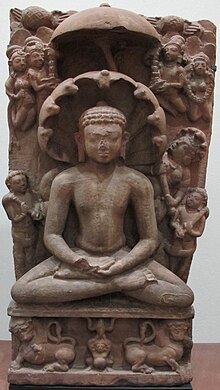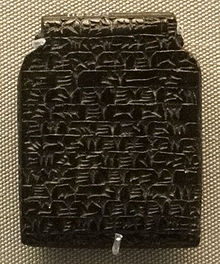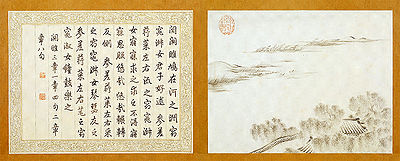 Parshvanatha
Parshvanatha (
Pārśvanātha), also known as
Parshva (
Pārśva), was the twenty-third
Tirthankara of
Jainism.
[4] He is the earliest Jain leader (
c. 872 – c.
772 BCE) for whom there is reasonable evidence of having been a historical figure.
Historicity[edit]
Circumstantial evidence including a description of the teachings of Parshvanatha in the Sayings of the Seers, dictates that Parshvanatha can be viewed as a historical figure.
Biography[edit]
Parshvanatha was born on the tenth day of the dark half of the month of
Paush to King Asvasena and Queen Vamadevi of Benaras (now
Varanasi). He belonged to the
Ikshvaku dynasty. He assumed and began to practice the twelve basic vows of the adult Jain householder when he reached the age of eight.
Parshvanatha lived as formal prince of Varanasi and at the age of thirty, he renounced the world to become a monk. He meditated for eighty-four days before attaining
Kevala Jnana. He achieved
moksha at the age of one hundred atop
Shikharji, which is known today as the
Parasnath Hills after him. Parshvanatha was called
purisādāṇīya (beloved of men), a name which shows that he must have been a genial personality. He remains beloved among
Jains.
Previous Births[edit]
- Marubhuti - Visvabhuti, the prime minister of King Aravinda had two sons, elder one named Kamath and younger one named Marubhuti (Parshvanatha). Kamath killed Marubhuti and died as a criminal.
- Elephant - He was then reborn as an elephant in the forests of Vindyachal. His name was Vajraghosha (Thundering Voice of Lightening). Meanwhile, King Aravinda, after death of his minister Marubhuti, renounced his throne and was leading an ascetic life. When the elephant came near Aravinda, he recalled his previous human life by the blessings of Aravinda and became calm. Kamath was reborn as a serpent this time. One day, when the elephant went to a river to quench his thirst, the serpent attacked him and he died the peaceful death of absolute renunciation.
- Sasi-prabha - Vajraghosha was reborn as Sasi-prabha (splendor of the moon) in the twelfth heaven and the serpent went to hell.
- Agnivega - After spending a luxurious life in heaven, he was reborn as prince Agnivega (strength of fire). He ascended the throne of his father which he later renounced to lead an ascetic life. Kamath was reborn as a serpent again after hell and again killed the ascetic in Himalayas during penance.
- When he was a prince he saved two snakes that had been trapped in a log in an Kamath’s fire. Later, the snakes were reborn as Dharnendra, the lord of the underworld kingdom of the nāgas, and Padmavati. Dharnendra and Padmavati sheltered Parshvanatha from a storm sent by a Meghmali (Kamath reborn).[26]
Teachings[edit]

18 feet (5.5 m) sculpture of Parshvanatha in the Parshvanatha basadi at
Halebidu
According to the
Kalpa Sūtra, Parshvanatha had 164,000
śrāvakas (male lay followers) and 327,000 śrāvikās (female lay followers) and 16,000
sādhus (monks) and 38,000 sādhvīs (nuns). He had eight
ganadharas (chief monks): Śubhadatta, Āryaghoṣa, Vasiṣṭha, Brahmacāri, Soma, Śrīdhara, Vīrabhadra and Yaśas. After his death, the ganadhara Śubhadatta became the head of the monastic order. He was then succeeded by Haridatta, Āryasamudra and
Keśī.
Śvētāmbara texts explain that a sage named, Keśī was born about 166 to 250 years after the death of Parshvanatha met the
Indrabhuti Gautama, the chief disciple of Mahavira and asked him twelve questions. One of the question as mentioned in Śvētāmbara text was "The Law taught by the great sage Parsva, recognises but four vows, whilst that of Vardhamana enjoins five". Therefore, according to Śvētāmbara texts, Parshvanatha taught four vows instead of the presently famous five vows (
mahavratas).
[28] This view is however not accepted by the Digambaras. On this,
Champat Rai Jain in his essay titled "
The Origin of The Swetambara Sect" wrote:
The first question Kesi put to Gautam was why did Mahavira insist upon the observance of five vows when Parashvanath did not mention five but only four, excluding celibacy? But the question would have had a point if it could be shown that salvation could be obtained without the observance of celibacy. So far as I understand Swetambara books themselves insist upon an observance of this vow, and it is not possible that two omniscient teachers, i. e., Parashvanath and Mahavira could teach different things.
In literature[edit]
Kalpa Sūtra is biographies of the Jain Tirthankaras, notably Parshvanatha and Mahavira.
Iconography[edit]
Parshvanath is the most popular object of Jain devotion. He is closely associated with compassion, although he is free from the world of rebirth like all Tirthankaras and therefore unable to aid his devotees
 The Odyssey (/ˈɒdəsi/;[1] Greek: Ὀδύσσεια Odýsseia, pronounced [o.dýs.sej.ja] in Classical Attic) is one of two major ancient Greek epic poems attributed to Homer. It is, in part, a sequel to the Iliad, the other work ascribed to Homer. The Odyssey is fundamental to the modern Western canon, and is the second-oldest extant work of Western literature; the Iliad is the oldest. Scholars believe the Odyssey was composed near the end of the 8th century BC, somewhere in Ionia, the Greek coastal region of Anatolia.[2]
The Odyssey (/ˈɒdəsi/;[1] Greek: Ὀδύσσεια Odýsseia, pronounced [o.dýs.sej.ja] in Classical Attic) is one of two major ancient Greek epic poems attributed to Homer. It is, in part, a sequel to the Iliad, the other work ascribed to Homer. The Odyssey is fundamental to the modern Western canon, and is the second-oldest extant work of Western literature; the Iliad is the oldest. Scholars believe the Odyssey was composed near the end of the 8th century BC, somewhere in Ionia, the Greek coastal region of Anatolia.[2]





